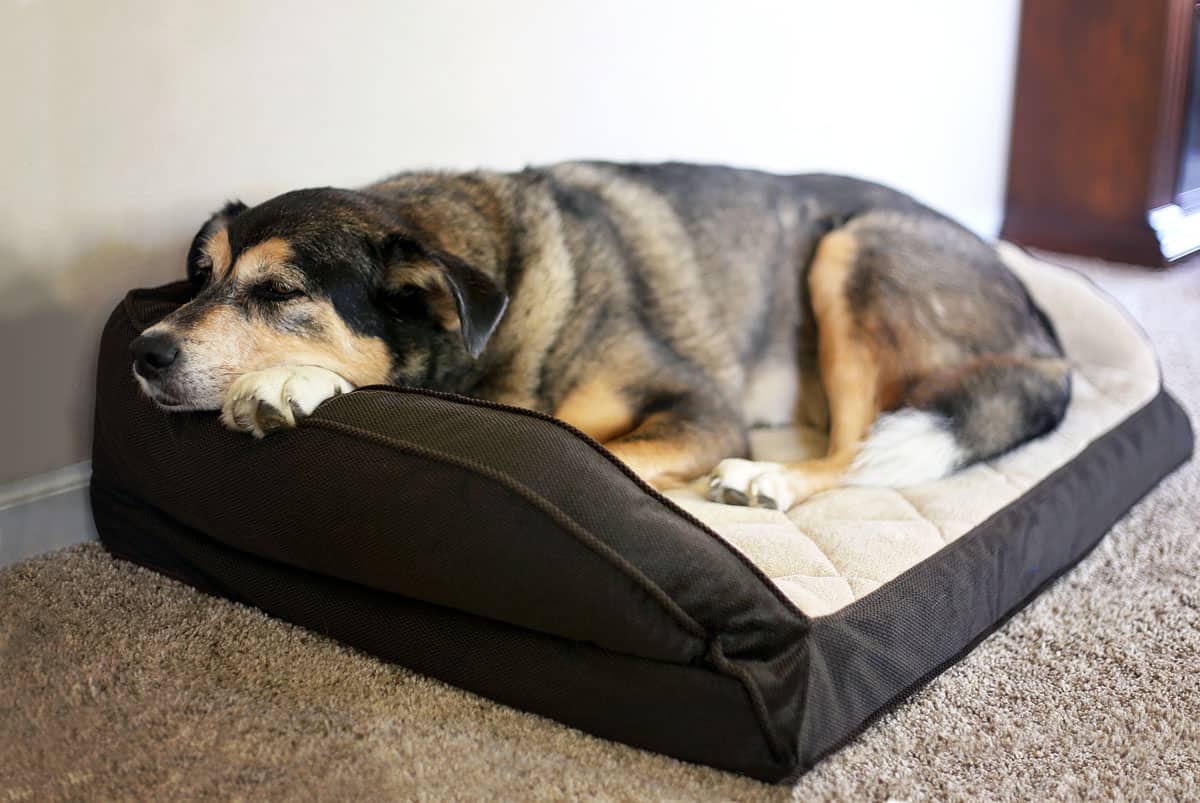Arthritis in Dogs
Arthritis in Dogs
Arthritis in dogs is a common disease.
Arthritis affects 20% of adult dogs and 80% of geriatric dogs. Even young dogs can be affected, if a predisposing condition is present. It also affects geriatric cats and rabbits.
What is arthritis in dogs?
Arthritis is a chronic degenerative disease that affects the most common joints such as the shoulders, knees, hips and elbows. The cartilage that lines and cushions the joints becomes eroded. This exposes the bone ends, leading to painful bone spurs. The joint lining also becomes inflamed and thickened, reducing mobility.
Old age arthritis also known as osteoarthritis is very common in both humans and dogs, and widely regarded as the same disease. If you’ve noticed over time that your dog is reluctant to play, is lagging behind on walks, yelping when touched or has increased difficulty climbing stairs, your pet may be suffering from arthritis.
Thanks to advances in veterinary medicine, many dogs live well past their prime years and while arthritis cannot be cured, any discomfort or pain they experience can be effectively managed and controlled.
Is arthritis common in younger dogs or older dogs?
Arthritis is relatively common in older dogs, and like humans, the result of daily wear and tear. The cartilage in between the joints deteriorates over time and the synovial fluid loses its lubricating properties resulting in inflammation and friction between the bones that causes reduced mobility and discomfort.
It’s not unusual to see symptoms of arthritis in dogs as young as six or seven years of age however it’s usually due to secondary factors that contribute to the progression of the disease such as ligament damage, poor nutrition, age and overweight dogs and dogs that suffer from immune diseases.

Are certain dog breeds more susceptible to developing arthritis?
We would not say a certain type of breed is predisposed to developing arthritis but rather that the disease is typically seen in large breed dogs. Overweight animals proportionately carry more weight on the joints, leading to an increased chance of localised inflammation and irritation to the joints. This is not to say that your Pug doesn’t have arthritis, it’s simply less common in smaller dog breeds so regardless of the breed it’s important to maintain a healthy weight.
What are the signs and symptoms of arthritis in dogs?
Clinical signs would include lameness and mobility difficulties such as jumping, getting in and out of their bed or climbing stairs. Sometimes owners report a change in behaviour, lethargy, some react to the pain but shying away from touch or becoming more aggressive. The signs and symptoms are not always obvious and can be as subtle as slightly longer periods of rest and a reluctance to go for a walk.
Common symptoms of osteoarthritis in dogs include:
- Lameness
- Reluctance to jump onto furniture or into the car
- Slow to get up after lying down
- Stiffness after exercise
- Avoiding the stairs
- “Slowing down” – less willing to go for walks or play
- Change in personality – becoming grumpy or irritable
Can you see visible signs of arthritic swelling?
What we often see is degenerative muscle wastage because your dog does not use the affected leg there can be signs of limping and general muscle mass loss over the spine and affected areas. Osteoarthritis commonly affects areas such as the hips, knee joint, shoulders and elbows, and sadly the condition worsens over time degrading the cartilage between the joints and the carpal joint in the front leg. It is not uncommon for dogs to experience pain along the spinal column as a result of the body compensating for areas of weakness.
How can we prevent arthritis in the first place in dogs?
First of all, maintaining an active lifestyle and lean body weight plays a big role in maintaining healthy joints. Following a prescription diet such as Royal Canin means you are guaranteed of providing your pooch with quality ingredients that includes omega three fatty acids, glucosamine, chondroitin and vital supplements that help to improve the quality of the cartilage and reduce painful inflammation.
If you suspect your dog may be showing signs of osteoarthritis, it is important to have your veterinarian conduct a physical examination to assess their range of motion. Your veterinarian may also recommend X-rays of the affected joints, which will help rule out other conditions that can cause similar symptoms such as Cruciate ligament damage or patella luxation. stabilizing the joints and treating susceptible areas early helps to slow the degenerative progression and prevent any further joint damage. In severe cases bone or cartilage particles float in the joint cavity causing significant pain and inflammation. These particles need to be surgically removed and, in some cases, it may become necessary to fuse the joint, an advanced surgical procedure used to salvage the bone.

Are there supplements that help to prevent arthritis in dogs?
The prescription diets such as Hills, JD, Royal Canin Mobility are all specifically formulated and fortified with omega fatty acids, fish oils, glucosamine and supplements that protect the joints. While there are numerous homeopathic and home remedies out there, there is no
conclusive evidence that ingredients such as turmeric are in fact effective.
How to manage / treat arthritis in dogs
One of the most important aspects of managing any animal with arthritis is to make sure that their pain is carefully managed and that they continue to live a good quality life.
Treatment may include daily anti-inflammatory medication to reduce the inflammation around the joint in conjunction with a weight management plan to reduce any pressure in the affected joints. A full blood test is conducted before starting any pain relief medication
Anti-inflammatory or non-steroidal anti-inflammatory drugs (NSAIDS) do have side effects and your veterinarian will need to keep a close check on your dog’s kidney and liver function to appropriately manage the best dosage, based on the dog’s health history. The other option in terms of medication is a disease modifying osteoarthritis drug called Zydax, this disease modifying medication is used to improve and protect the quality of the cartilage, widely referred to as a Chrondro protective drug that improves blood circulation and supports biosynthetic function of chondrocytes. An injectable course of Zydax is typically administered over four doses, one week apart and repeated once every six months.
Joint Supplement- Chrondroitin Sulfate, glucosamine Sulfate, Omega-3 -fatty- acid supplementation are commonly used supplements. There are a range of brands out there including Antinol, Glyde and 4 Cyte.
Treatment is a multimodal approach and while surgery is sometimes unavoidable, we adopt a holistic approach to treatment first. It is recommended that limiting high impact activities such as jumping and running, continuing regular walks or swimming is a great form of exercise that places the least amount of strain on painful joints. We combine the best possible treatment options in order to achieve the best quality of life for our pooch patients.
As osteoarthritis is a chronic, progressive condition there is no cure. However, we have a range of options to manage the disease and keep the pet as comfortable as possible. This involves using a combination of treatment options:
- Weight management:this is the mainstay of osteoarthritis management. We want the pet to be in a lean, healthy body condition to avoid putting extra stress on the joints. If the pet is overweight/obese then getting it onto a weight loss plan is essential.
- Exercise management: exercise will help maintain the muscles which will, in turn, support the joints. Regular, low impact exercise is recommended. Uncontrolled exercise (running, jumping, twisting when chasing balls or on the beach) will put extra strain on the joints. Another beneficial exercise is swimming – this is non-weight bearing and provides resistance which encourages muscle development without putting extra stress on the joints.
- Therapeutic diets: Hills J/d or Metabolic + Mobility (if weight loss is needed) are both designed to help arthritis. They have a specific combination of essential fatty acids which helps to reduce pain and inflammation in the joints and support the cartilage.
- Zydax (pentosan polysulphate) injections:this a course of injections weekly for 4 weeks, every 6 months. Zydax reduces inflammation of the joint and helps to protect the cartilage from further damage. It is very safe and is often started in younger dogs with hip or elbow dysplasia or after surgery to help prevent early onset of arthritis.
- Nonsteroidal anti-inflammatories (NSAIDs): These are medications which help to relieve pain and inflammationin the joints. A blood test is recommended prior to starting this medication as long-term use can cause liver and kidney problems.
- Gabapentin (Neurontin): This is another pain relief medication which acts in a different manner to NSAIDs. It is good for chronic painand is safer for long term use in terms of liver and kidney function.
- Nutraceuticals: examples include fish oil, chondroitin and glucosamine supplements. They may help to reduce inflammationof and protect the joints. They can be given long-term to help with management.
- Surgery: surgical correction of conditions like patellar luxation and cruciate disease will help to delay the onset of arthritis by creating a more stable joint. Elbow dysplasia and hip dysplasia may also need surgery depending on the severity.
If you notice any signs of symptoms that indicate your dog may be suffering from arthritis, call us on (08) 8340 0388 at Port Road Vet to see how we can help.

